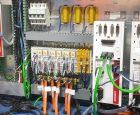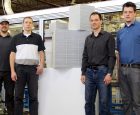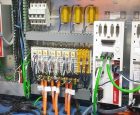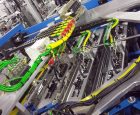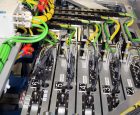
Standardizing machine design with PC-based control
November 22, 2018
By Shane Novacek

November 22, 2018 – Old adages advise against reinventing the wheel, but what is a manufacturer to do when customers all want different wheels?
Answering this question for global manufacturers every day is RAMP, Inc., an automation technology services provider located in Waterloo, Ontario. RAMP develops custom solutions that balance highly tailored manufacturing functionality with standardized connectivity, operation and maintainability.
RAMP has tackled many large-scale automation projects across North America and Europe in numerous industries. The company has deep application experience in many markets, with particular strength in energy recovery and automotive projects, and also has major clients in healthcare and consumer products manufacturing, electronics assembly, food production, and scientific research at various universities and institutes.
With increasing domestic manufacturing activity in industrialized countries, manufacturers need more efficient production methods to improve global competitiveness. “For example, there is a strong push in domestic automotive manufacturing to increase the adoption of techniques such as lightweighting to make vehicles more fuel efficient and handle better when driving,” says Michael Balzan, director of RAMP.
“The burgeoning electric vehicle market is also driving manufacturing investments and will continue to rapidly expand in the near future. We see major developments in machine autonomy, with IoT becoming more pervasive across industries.” These transformative changes push manufacturers to adopt next-generation manufacturing technologies, and the engineering team at RAMP can handle all the design aspects, including mechanical components, automation and controls.
RAMP projects can involve the manufacturing of new products without predefined processes, and they can also modernize and replace legacy systems. To cover the entire application spectrum, RAMP follows a structured project management development (PMD) model that stresses agile engineering. This supports concurrent project development and engineering to optimize all processes.
“RAMP provides customers a significant value-add through proper and thorough engineering analyses of the end users’ products and processes,” says Jeff Kerr, manager of mechanical design at RAMP. “We start this at the outset of system implementation – even before we think about the control platform. We cross-functionally examine all requirements and break them down into individual conceptual designs. This way, we ensure that all mechanical and control components are fully compatible, resulting in the best possible solutions for customers.”
Agile engineering
RAMP exudes creative engineering ideas through the company’s breadth of knowledge in diverse industries, and the company identifies potential risks upfront. From the first customer visit, the RAMP team manages risk with proof-of-concept consultation backed by practice-proven design techniques. “A strength at RAMP is our ability to rapidly customize solutions according to each customer’s unique needs,” explains Stephen Gugeler, manager of control systems at RAMP. “We can accommodate multiple part types and rapid changeover requirements while providing standard interfaces and production methodologies. Regardless of the particular machine type or range of products they’re manufacturing, custom solutions from RAMP are designed to be inherently familiar.”
With standardized machine design, RAMP customers that have multiple divisions or facilities can move cross-functional teams between facilities and still learn new processes quickly. This understanding spreads across engineering, technician and maintenance teams so all personnel can operate new machines and navigate changing manufacturing processes more easily.
A recent RAMP client to integrate custom-built machinery is CORE Energy Recovery Solutions based in Vancouver, British Columbia. A RAMP-built machine installed in 2018 at CORE manufactures energy recovery ventilators (ERVs) that increase air exchanger energy efficiency in residential and commercial buildings. The ERVs are used in the CORE Mustang cross-flow exchanger line.
The RAMP machine takes base materials, including a patented polymer membrane and aluminum foil, through the machine process that laminates layers of membrane and corrugated aluminum in various heights and pitches unique to each customer recipe. The second half of the machine takes the laminated materials through a high-precision vacuum conveyor designed and built by RAMP. This custom sheet layer then has separating materials placed on it using a unique pick-and-place process with common pick positions but recipe-driven place positions varying from 250 mm to one metre. Finally, the layers are stacked across multiple dimensions and heights to create the last recipe-driven dimension and then exited off a conveyor to the operator.
PC control software
RAMP has used PC- and EtherCAT-based control technology from Beckhoff Automation for over four years and has since increased its usage across the organization. “The Beckhoff control platform is the standard on three of our primary systems, including this web handling system for CORE, as well as our moulding machinery and measurement equipment used in automotive applications,” Gugeler says.
TwinCAT 3 software from Beckhoff allows RAMP to handle PLC and motion control, plus I/O mapping and configuration in a single software solution. The RAMP team creates code using various IEC 61131-6 languages, ensuring that the company’s standards-based approach extends to software engineering. TwinCAT also helps RAMP leverage open, vendor-neutral technologies like the OPC UA standard for secure connectivity to higher level databases such as Amazon Web Services (AWS) and SAP.
RAMP uses a variety of TwinCAT tools for high-speed data analysis and advanced code development. “TwinCAT 3 excels in all areas of PLC and motion control programming, but goes far beyond this,” Gugeler says. “For example, ScopeView makes troubleshooting and modification efforts faster and more efficient. And since the platform directly integrates with Microsoft Visual Studio, RAMP can take advantage of standard computer science tools and methods, such as C# for UI development. This means we can fully leverage emerging engineering talent from local universities and colleges. These new engineers entering the workforce are very familiar with IDEs like Visual Studio, but may not have interacted with a traditional PLC before.”
Industrial PCs
Based on the application requirements and specifications from CORE Energy Recovery Solutions, RAMP required a high-powered industrial PC (IPC) to handle all automation software and Windows applications, as well as the company’s recipe and data acquisition solutions. “We needed an IPC that could run our applications at a one millisecond update rate to provide maximum control over the process. That led us to the high-power, cabinet-mounted C6930 IPC from Beckhoff,” says Steve Slothouber, project control lead at RAMP. The C6930 that RAMP selected features a fourth-generation Intel Core i5 processor (two cores, 2.7 GHz).
RAMP connects the C6930 IPCs to CP2916 multi-touch control panels to display dashboards that run on an HMI server for local and web-based access. The dashboards are filled with overall equipment efficiency (OEE) information and important data from existing validation systems. RAMP uses two CP2916 panels with 15.6-inch displays for HMI hardware, allowing for easy operation and process control.
To cover I/O requirements, RAMP standardized on an EtherCAT system that offers analog and digital devices rated in IP 20 and IP 67 for all data acquisition and machine safety requirements. The IP 20 EtherCAT terminals result in a smaller enclosure footprint and permit a free mix of safe and non-safe I/O in the same segment. High-density (HD) EtherCAT terminals, which offer as many as 16 I/O channels in a 12-mm wide terminal housing, promote space savings. These also greatly reduce wiring effort through DIN rail installation and cage clamp wiring connections.
“The EtherCAT I/O system provided the high-speed networking and fast scan times we needed while ensuring flexible network topologies,” says Matt Buchwald, electrical design lead for RAMP. “The CORE application requires high-end control technology that can react to production changes and adjust output controls in under 10 milliseconds.” The application also had to integrate with various third-party field devices on different networks, and each protocol had to be managed in the central controller. In this case, the EtherCAT I/O system directly connects to EtherNet/IP hardware required on the machine. This included devices installed on web handling equipment, vision system hardware, automatic power tensioning controls and dispensing units.
In order to minimize wiring distances to field devices, RAMP uses machine-mounted EtherCAT Box I/O in IP 67 protection throughout the system. “This allows us to place our field inputs and outputs closer to the application and reduce overall cable length and cable track requirements,” says Buchwald. “Integrating all safety systems on the same EtherCAT network via TwinSAFE I/O further reduces overall cabling and electrical assembly time. The safe inputs and outputs efficiently connect with safety doors, light curtains, area scanners and e-stops. TwinSAFE also handles Safe Torque Off (STO) functionality on some hard-wired motion control equipment.”
For drive technology that would reduce cabinet space, RAMP applied 24-mm wide EL7211 servomotor terminals for some of the machine’s motion control requirements. “We can use one low-cost 48-volt power supply for the EL7211 drives, significantly reducing space and cost requirements for servo drives,” says Gugeler. Beckhoff stepper technology also factors into the application, with AS1020 stepper motors used for low-cost control of motion, velocity and position. These are driven by EP7041 stepper motor modules rated at 50 V DC, 5 A, with built-in incremental encoder for resonance-critical applications.
For higher power and load requirements, the RAMP machines also incorporate AX5000 series digital compact servo drives for high-end position control, electronic gearing, velocity control and super-imposed position control. The drives connect to AM8000 series servomotors, which cut up to 50 per cent of motor cabling and connectors, to handle conveyance, pick and place, web lamination, tension control and height adjustments for the production line.
Lowering costs
As the machine control system for CORE Energy Recovery Solutions evolved over a year of development, RAMP repeatedly added new field devices for data acquisition. “We were initially concerned about over-taxing the IPC from a data-processing perspective, but the system capably handled continual increases in data, even while handling all automation and control functionality,” says Balzan. “The stakes were high in this tight deadline project, because if the CPU and RAM couldn’t keep up, it would have required a major redesign.”
Since RAMP first transitioned to PC-based control and EtherCAT technology, the company has had ample time to compare metrics with older generation PLC- and PAC-based systems. “We clearly increased control quality, improved system reliability, increased productivity and boosted OEE for all RAMP solutions with PC-based control,” says Gugeler. “Specifically, we improved PLC cycle times by 30 per cent and reduced control system costs by approximately 30 per cent.”
With the results apparent in the company’s engineering approach to networking technology, RAMP continues to use PC-based control to create fully customized machines with the efficiency found in standard, series production machines.
Shane Novacek is the marketing communications manager for North America at Beckhoff Automation.
This article originally appeared in the November/December 2018 issue of Manufacturing AUTOMATION.
Advertisement
- Manufacturers see tax relief in Canada’s economic update
- Canada’s $16B business tax advantages to help competitiveness
